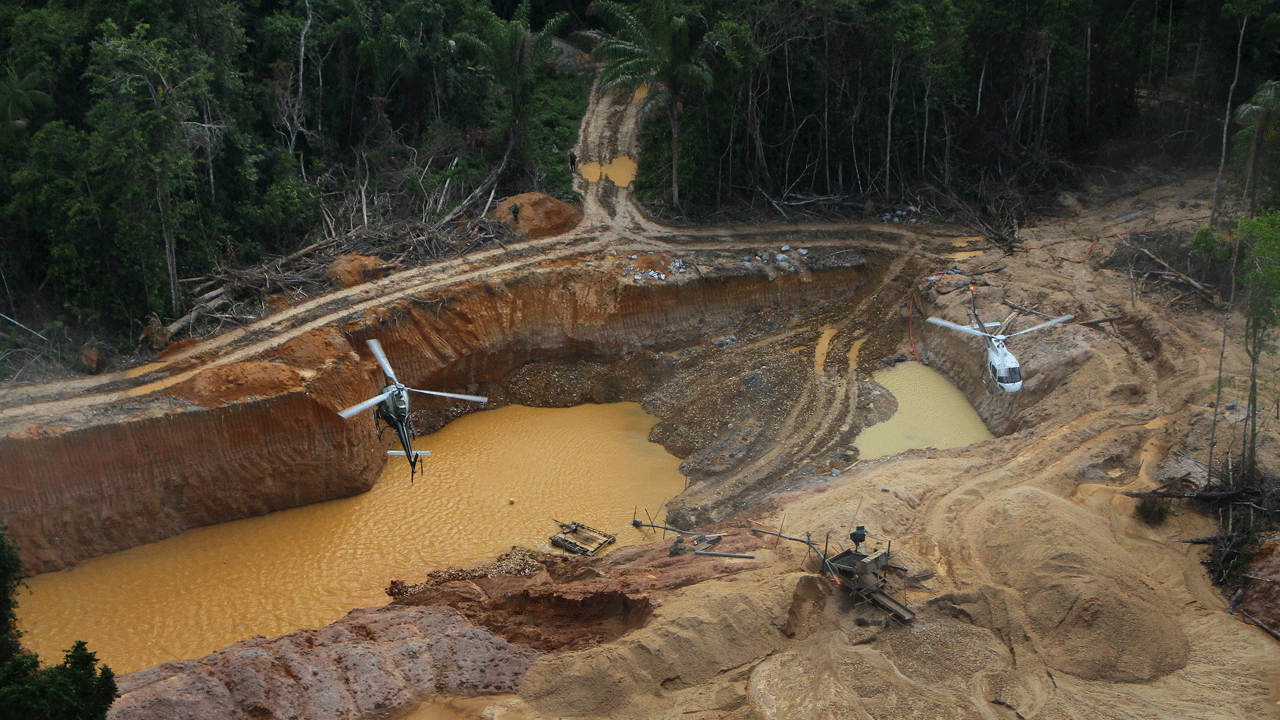INTERNACIONAL
Mercury exposure widespread among Yanomami tribe in Amazon, report finds

BRASILIA, Brazil (AP) — Many Yanomami, the Amazon’s largest Indigenous tribe, have been contaminated with mercury coming from widespread illegal gold mining, according to a report released on Thursday by Brazil’s top public health institute.
The research was conducted in nine villages along the Mucajai River, a remote region where illegal mining is widespread. Mercury, a poison, is commonly used in illegal mining to process gold.
BRAZIL, OTHER AMAZON RAINFOREST COUNTRIES TO MEET FOR THE FIRST TIME IN 14 YEARS OVER ENVIRONMENTAL THREATS
The researchers collected hair samples from nearly 300 Yanomami of all ages. They were then examined by doctors, neurologists, psychologists and nurses.

A Brazil Environmental Agency helicopter flies over an illegal mining camp during an operation to try to contain it in Yanomami Indigenous territory, Roraima state, Brazil, Feb. 11, 2023. The Yanomami are suffering from severe contamination of mercury coming from widespread illegal gold mining, according to a report released on Thursday, April 4, 2024, by Brazil’s top public health institute. ( AP Photo/Edmar Barros)
The vast majority, 84% of Yanomami tested, had contamination equal to or above 2 micrograms per gram, a level of exposure that can lead to several health problems, according to standards by the U.S. Environmental Protection Agency and World Health Organization.
Even more worrying, a smaller part of this group, 10%, surpassed the 6 micrograms per gram threshold, a contamination level often associated with more severe medical conditions.
Research teams also tested fish in the area, finding high levels in them. Eating fish with high mercury levels is the most common path of exposure.
Exposure studies usually test for methylmercury, a powerful neurotoxin formed when bacteria, in this case in rivers, metabolize inorganic mercury. Ingestion of large amounts over weeks or months damages the nervous system. The substance also can pass through a placenta of a pregnant woman, exposing a fetus to developmental abnormalities and cerebral palsy, according to the U.S. Centers for Disease Control and Prevention.
Health effects can include decreased sensitivity in the legs, feet, and hands, overall weakness, dizziness, and ringing in the ears. In some cases, a compromise of the central nervous system can lead to mobility issues.
«Chronic exposure to mercury settles in slowly and progressively,» Paulo Basta, an epidemiologist with the Oswaldo Cruz Foundation, which led the testing, told The Associated Press. «There’s a wide spectrum of clinical actions that range from mild to severe symptoms.»
Concerted global efforts to address mercury pollution led to the 2013 Minamata Convention, a UN-backed agreement signed by 148 parties to curb emissions. The treaty is named after the Japanese city of Minamata, whose population was contaminated by decades-long emissions of mercury dumped along with wastewater. Brazil and the United States were among the signatories.
The Brazilian government report has not been peer reviewed but synthesizes three papers published recently in the journal Toxics, all based on the same field work. One of the studies noted that determining what long-term mercury exposure levels constitute a significant risk for health remains a challenge.
The study’s findings align with prior research in other areas of the Amazon, said Maria Elena Crespo López, a biochemist at the Federal University of Pará who was not involved in the report and has studied the subject for 20 years.
«The mercury problem is widespread throughout the Amazon,» she told the AP. «Since the 1970s, when the first major gold rush happened here, mercury has been released for decades and ends up being transported over long distances, entering the food chain.»
A global review of mercury exposure in the journal Environmental Health Perspectives in 2018 identified Amazon river tributary communities as one of four communities of most concern.
The World Health Organization ranks small-scale gold mining as the single largest source of human-led contamination. The Yanomami territory, which spans the size of Portugal and has a population of 27,000, has endured decades of this illegal activity.
The mining problem significantly expanded during the four-year term of far-right President Jair Bolsonaro, which ended in 2022. He defanged Brazil’s environment protection agencies amid rising gold prices. The combination caused a rush of thousands of miners onto Yanomami lands. Basta said that during the fieldwork, which took place near the end of Bolsonaro’s term, Mucajai was teeming with illegal miners.
Upon arrival by plane, the 22-strong team had to wait for about hours to proceed by boat due to heavy gold barge traffic in the Mucajai River. During ten days of testing, researchers were guarded by four military police carrying machine guns and grenades. Basta recalls counting 30 to 35 small planes flying to and from illegal mining sites each day.
«The tension was present throughout our entire stay in the village. I have been working in indigenous villages for 25 years, and it was the most tense work I have done,» he said.
CLICK HERE TO GET THE FOX NEWS APP
Current President Luiz Inácio Lula da Silva has pledged to expel gold prospectors from Yanomami territory and improve health conditions, but the task is far from complete.
«Mining is the biggest threat we face in Yanomami land today,» Yanomami leader Dário Kopenawa said in a statement. «It’s mandatory and urgent to expel these intruders. If mining continues, so will contamination, devastation, malaria, and malnutrition. This research provides concrete evidence of it.»
INTERNACIONAL
Former Australian PM deletes critical tweets of Trump after winning election: ‘Most destructive president’

Former Australian prime minister and current ambassador to the United States in Washington Kevin Rudd has deleted tweets critical of President-elect Donald Trump after he won the presidential election.
Rudd had described Trump in a 2020 post as «the most destructive president in history,» according to reporting from NDTV.
He served as Australia’s 26th prime minister from 2007 to 2010 as head of their Labor Party, and was re-elected in 2013 after a brief stint as Australia’s foreign minister.
AUSTRALIA ANNOUNCES PLAN TO BAN SOCIAL MEDIA FOR KIDS UNDER 16
The comments were made when Rudd had served as Chair of the Asia Society Policy Institute, which was described by Columbia University World Leaders Forum as «dedicated to using second track diplomacy to assist governments and businesses in resolving policy challenges within Asia, and between Asia and the West.»
Former Prime Minister Kevin Rudd during the unveiling of his official portrait by Ralph Heimans, at Parliament House in Canberra. August 10th, 2023. (Alex Ellinghausen / The Sydney Morning Herald via Getty Images)
According to a statement shared with Fox News Digital from Ambassador Rudd’s office, «In his previous role as the head of an independent US-based think tank, Mr. Rudd was a regular commentator on American politics. Out of respect for the office of President of the United States, and following the election of President Trump, Ambassador Rudd has now removed these past commentaries from his personal website and social media channels.»
MURDOCH CHILDREN’S RESEARCH INSTITUTE UNVEILS NEW INITIATIVE AT AMERICAN AUSTRALIAN ASSOCIATION BENEFIT DINNER
«This has been done to eliminate the possibility of such comments being misconstrued as reflecting his positions as Ambassador and, by extension, the views of the Australian Government. Ambassador Rudd looks forward to working with President Trump and his team to continue strengthening the US-Australia alliance,» the statement concluded.
Ambassador Rudd has since shared several posts congratulating President-elect Trump on social media site X, including one where he claimed he called him personally.

Republican presidential nominee, former U.S. President Donald Trump arrives to speak during an election night event at the Palm Beach Convention Center on November 06, 2024, in West Palm Beach, Florida. Americans cast their ballots today in the presidential race between Republican nominee former President Donald Trump and Vice President Kamala Harris, as well as multiple state elections that will determine the balance of power in Congress. (Chip Somodevilla/Getty Images)
In his post from November 6, Rudd wrote «Good to speak this morning with President Trump to personally congratulate him on his election victory. We talked about the importance of the Alliance, and the strength of the Australia-US relationship in security, AUKUS, trade and investment. I look forward to working together in the interests of both our countries.»
The AUKUS agreement is a trilateral union between the United States, Australia, and the United Kingdom established in 2021 to promote security in the Indo-Pacific region.
CLICK HERE TO GET THE FOX NEWS APP
The office of Ambassador Kevin Rudd provided no further comment to Fox News Digital’s inquiry.
-
POLITICA3 días ago
El Gobierno anunció la implementación del nuevo Código Procesal Penal Federal en dos provincias
-
POLITICA2 días ago
Ricardo Jaime se entregó en Comodoro Py: cumplirá su condena por la tragedia de Once en prisión
-
POLITICA1 día ago
Javier Milei y el gabinete felicitaron a Donald Trump: “Puede contar con Argentina para llevar a cabo su tarea”
-
INTERNACIONAL2 días ago
¿A qué hora se conocerán los resultados oficiales de las elecciones en Estados Unidos 2024?
-
POLITICA1 día ago
El Gobierno advirtió que cerrará Aerolíneas Argentinas si los gremios no frenan las medidas de fuerza
-
ECONOMIA2 días ago
Elecciones EE.UU.: El ‘arma de doble filo’ que puede alargarse en el tiempo Por Investing.com










































